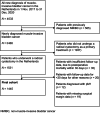The impact of positive surgical margins after cystectomy on oncological outcomes: a nationwide study
- PMID: 39631746
- PMCID: PMC11975155
- DOI: 10.1111/bju.16611
The impact of positive surgical margins after cystectomy on oncological outcomes: a nationwide study
Abstract
Objective: To evaluate whether surgical margin status, alongside existing postoperative risk indicators, improves the identification of bladder cancer patients who may benefit from adjuvant therapy following radical cystectomy (RC).
Methods: In this nationwide cohort study, patients aged ≥18 years diagnosed with muscle-invasive bladder cancer (MIBC) without nodal or distant metastasis (cT2-4aN0/xM0) between November 2017 and December 2020 who underwent RC were selected from the Netherlands Cancer Registry. Detailed information on surgical margin status was obtained through linkage with the Dutch central pathology database, Palga. Overall survival (OS) and progression-free survival (PFS) were assessed using the Kaplan-Meier method. Multivariable Cox regression analysis was performed to assess the independent prognostic effect of positive surgical margins (carcinoma in situ (CIS) only or invasive carcinoma) on PFS and OS.
Results: We identified 1445 MIBC patients treated by RC (53% open, 47% robot-assisted), of whom 135 (9.3%) had positive surgical margins (10.7% in the open and 7.7% in the robot-assisted cohort). In the entire cohort, OS was 79% and 60% at 12 and 48 months after RC, respectively. PFS was 70% and 61% at 12 and 24 months, respectively. Multivariable Cox regression showed worse PFS (hazard ratio (HR) 2.13, 95% confidence interval (CI) 1.67-2.72) and OS (HR 2.02, 95% CI 1.58-2.58) in patients with surgical margins with invasive carcinoma vs patients with negative margins. Patients with only CIS in the margins also appeared to have worse PFS (HR 1.60, 95% CI 1.00-2.58) but these results were not statistically significant. No difference was found for OS (HR 1.30, 95% CI 0.80-2.12).
Conclusion: Positive margins should be considered a 'high risk feature', as they result in increased risk of disease progression and impaired survival outcomes. These findings support further investigation of the potential efficacy of adjuvant therapy (i.e., radiotherapy and systemic therapy) among patients with positive surgical margins.
Keywords: adjuvant therapy; muscle‐invasive bladder cancer; overall survival; radical cystectomy; surgical margins.
© 2024 The Author(s). BJU International published by John Wiley & Sons Ltd on behalf of BJU International.
Figures


Similar articles
-
Intermediate-term survival of robot-assisted versus open radical cystectomy for muscle-invasive and high-risk non-muscle invasive bladder cancer in The Netherlands.Urol Oncol. 2022 Feb;40(2):60.e1-60.e9. doi: 10.1016/j.urolonc.2021.06.018. Epub 2021 Jul 22. Urol Oncol. 2022. PMID: 34303597
-
National Practice Patterns and Overall Survival After Adjuvant Radiotherapy Following Radical Cystectomy for Urothelial Bladder Cancer in the USA, 2004-2013.Eur Urol Oncol. 2020 Jun;3(3):343-350. doi: 10.1016/j.euo.2018.11.010. Epub 2018 Dec 19. Eur Urol Oncol. 2020. PMID: 31317867 Free PMC article.
-
The effect of the time interval between diagnosis of muscle-invasive bladder cancer and radical cystectomy on staging and survival: A Netherlands Cancer Registry analysis.Urol Oncol. 2016 Apr;34(4):166.e1-6. doi: 10.1016/j.urolonc.2015.11.006. Epub 2015 Dec 15. Urol Oncol. 2016. PMID: 26705102
-
Clinicopathological factors in bladder cancer for cancer-specific survival outcomes following radical cystectomy: a systematic review and meta-analysis.BMC Cancer. 2019 Jul 19;19(1):716. doi: 10.1186/s12885-019-5924-6. BMC Cancer. 2019. PMID: 31324162 Free PMC article.
-
Concomitant carcinoma in situ may not be a prognostic factor for patients with bladder cancer following radical cystectomy: a PRISMA-compliant systematic review and meta-analysis.World J Urol. 2020 Jan;38(1):129-142. doi: 10.1007/s00345-019-02738-2. Epub 2019 Mar 27. World J Urol. 2020. PMID: 30919100
References
-
- Stein JP, Lieskovsky G, Cote R et al. Radical cystectomy in the treatment of invasive bladder cancer: long‐term results in 1,054 patients. J Clin Oncol 2001; 19: 666–675 - PubMed
-
- Dalbagni G, Genega E, Hashibe M et al. Cystectomy for bladder cancer: a contemporary series. J Urol 2001; 165: 1111–1116 - PubMed
-
- Witjes JA, Bruins HM, Albert C et al. European Association of Urology guidelines on muscle‐invasive and metastatic bladder cancer: Summary of the 2023 guidelines. Eur Urol 2023; 85: 17–31 - PubMed
-
- Advanced Bladder Cancer (ABC) Meta‐analysis Collaboration . Neoadjuvant chemotherapy in invasive bladder cancer: update of a systematic review and meta‐analysis of individual patient data; advanced bladder cancer (ABC) meta‐analysis collaboration. Eur Urol 2005; 48: 202–205 - PubMed
MeSH terms
Grants and funding
LinkOut - more resources
Full Text Sources
Medical

